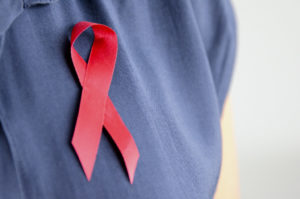By Brooke Davidoff
 World AIDS Day was December 1st. I did not know that until 2010.
World AIDS Day was December 1st. I did not know that until 2010.
It was his 21st birthday when our flirting elevated to kissing. He told the bartender he wanted me for his birthday. At the age of 23, one of the only things on my mind when it came to dating was for me to not get pregnant before I was married.
Within weeks of seeing each other I went to Planned Parenthood and got on birth control. Blake and I went to the same high school he played football and wrestled. In my mind, that made him safe. He said he had only been with four other girls, and I knew three of them. I did not need to make him wear condoms because I was on the pill—so I thought. I never missed an OBGYN appointment for my annual Pap smear or birth control renewal.
Six years later I was married to someone else and pregnant. Following routine blood work I was called into my doctor’s office after hours. My husband and I arrived curious and apprehensive. It was that night when my OBGYN told me that I was HIV positive. Human immunodeficiency virus, or HIV was not anything I had been told I was at risk for by my doctors previously. As a straight cis woman, I naively believed I was not at risk. I was then told about HIPPA and my right to not tell anyone about my diagnosis.
The symptoms of HIV would never have lead me to believe I had a deadly STD. I was handed a list of symptoms, dumbfounded as I glanced at them. Well yes, who doesn’t have these?
- Chills
- Rash
- Muscle aches
- Sore throat
- Swollen lymph nodes
- Mouth ulcers
- Bad yeast infections
- Feeling tired, dizzy, and lightheaded
- Headaches
- and much more
Accessing STD prevention is a barrier for gender minorities. Cis men can often pressure partners into letting them skip the condom by complaining about discomfort or a lack of pleasure. In my case, and the cases of many other cis women, this puts us at higher risk of contraction. I never made a guy I dated wear a condom when I was on birth control, but I should have. Furthermore, transgender people have higher rates of HIV infection than the general population, transgenderwomen being 49 times more likely to have HIV. This is often considered a stigma against trans people, but this is a result of “social and legal exclusion, economic vulnerability, and an increased risk of experiencing violence. Disempowerment and low self-esteem make transgender women, in particular, less likely or less able, to negotiate condom use.” Also, unfortunately, “HIV-related stigma and transphobia create barriers to the access of HIV testing and treatment services by transgender people.”
Conversations about sex can be awkward, even with an intimate partner. You may feel like being in an exclusive relationship keeps you safe, but unless you and your partner get tested for STDs, you really have no idea if you are clean. HIV is invisible for years as it internally ravages your immune systems’ CD4 or T-cells. Once infected it can take years for someone to become sick. You will not be able to tell by looking at your partner. Get tested. Use protection.